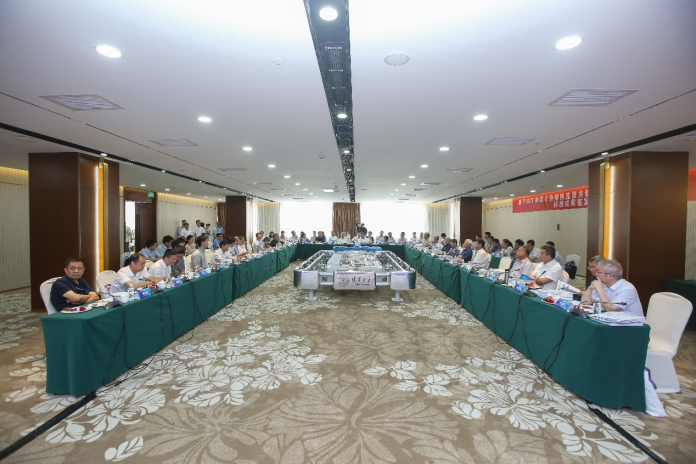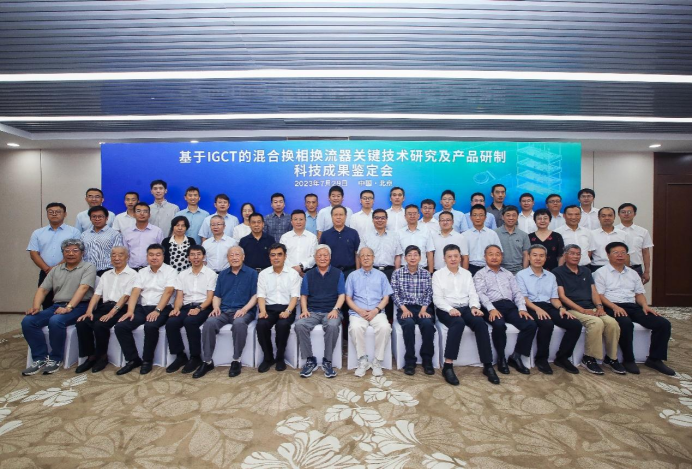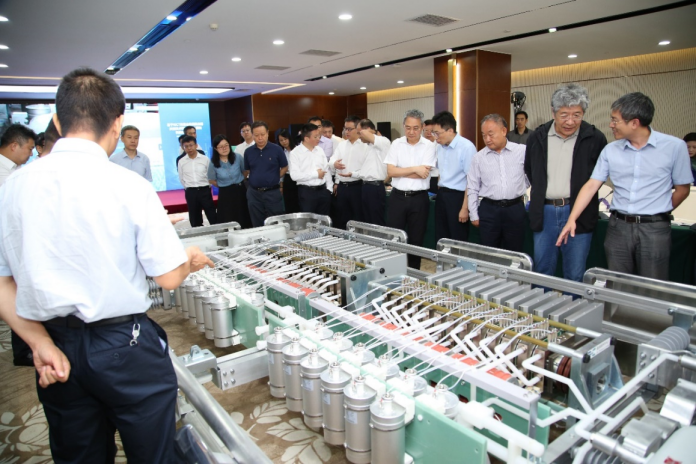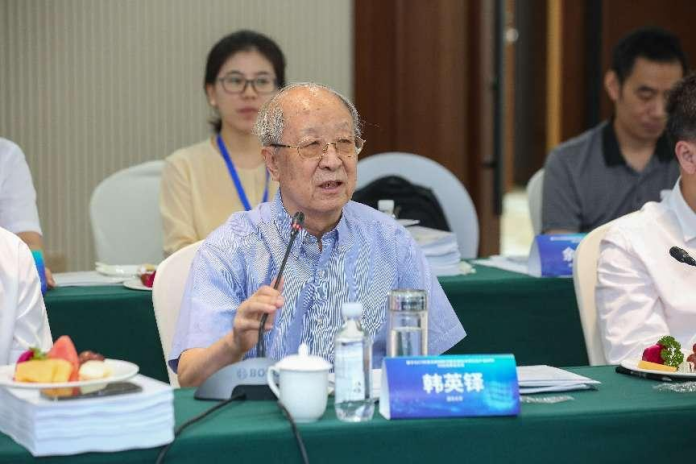On July 29, the Technology Assessment Conference for the project “Research and Product Development of Key Technologies for Hybrid Line-Commutated Converters based on IGCT”, organized by China Machinery Industry Federation, was held in Beijing using a hybrid format of both online and offline participation. More than 70 attendees, including experts from the assessment committee, representatives from China Machinery Industry Federation, as well as personnel from Tsinghua University, Xi’an Xidian Power System Co., Ltd., Huairou Laboratory, State Grid Henan Provincial Power Company, Xi’an Peri Power Semiconductor Converter Technology Co., Ltd., and Tsinghua Sichuan Energy Internet Research Institute, attended the event. Following inquiries, clarifications and discussions, the assessment committee unanimously concluded that “this technological achievement possesses complete independent intellectual property rights” and “overall, it has reached an international leading level,” thereby recommending its accelerated implementation in engineering applications.

At the assessment conference
The assessment committee was chaired by Academician Zhou Xiaoxin from China Electric Power Research Institute, with Academician Li Licheng from Southern Power Grid Company and Academician Shu Yinbiao of State Grid Corporation of China serving as vice-chairmen. Committee members included Academician Luo An from Hunan University, Academician Wang Qiuliang from the Institute of Electrical Engineering, Chinese Academy of Sciences, Academician Rao Hong from Southern Power Grid Company, Professor Zeng Nanchao from China Electric Power Research Institute, Chief Engineer Wang Jifeng from Southern Power Grid Company, Party Secretary Dong Yu of the Dispatching Center of State Grid Corporation of China, Deputy Director Guo Xianshan of the Equipment Department of State Grid Corporation of China, Director Du Zhongming of the Electric Power Planning and Design Institute, Professorate Senior Engineer Li Chongjian of the Metallurgical Automation Research and Design Institute, Professor Cui Xiang from North China Electric Power University, Assistant to the President Wen Jinyu of Huazhong University of Science and Technology, Professor and Vice President Ding Lijian of Hefei University of Technology, Chief Expert Yao Sili of Xi’an High Voltage Apparatus Research Institute, Director Zhang Guohua of the DC Technology Center of State Grid Corporation of China, Director Li Ming of the DC Center of the Economic and Technological Research Institute of State Grid Corporation of China, and Professorate Senior Engineer Nie Dingzhen of the Economic and Technological Research Institute of State Grid Corporation of China.

Group photo of attendees (part)
Leaders from the participating units, including Academician Han Yingduo of Tsinghua University, Professor Kang Chongqing, Dean of the Department of Electrical Engineering, Deputy Party Secretary/General Manager Zhou Qun of China Electric Equipment Group and Department Head Zhang Fan of the Department of Science and Innovation of China Electric Equipment Group, Deputy General Manager Xie Qingfeng of China Western Power Co., Ltd., Department Head Li Binbin of the Department of Science and Innovation of China Western Power Co., Ltd., General Manager Lou Yantao of Xi’an Xidian Power System Co., Ltd., Department Head Pang Hui of the Science and Innovation Department of Huairou Laboratory and Deputy Director Wei Xiaoguang of the New Power System Research Center of Xi’an Xidian Power System Co., Ltd., Wang Jinxing, former Chairman, and Song Wei, Deputy General Manager of State Grid Henan Power Company, Deputy General Manager Pang Yanli and Deputy Chief Engineer Zhang Lei of Xi’an Peri Power Semiconductor Converter Technology Co., Ltd., were also invited to the conference.

Speeches by leaders from participating units
After the conference commenced, Professor Kang Chongqing and General Manager Zhou Qun delivered speeches on behalf of the participating units.

Professor Zeng Rong of Tsinghua University presented a work report

Associate Professor Yu Zhanqing gave a technical report
Professor Zeng Rong and Associate Professor Yu Zhanqing of Tsinghua University, respectively on behalf of participating units, gave a work report and a technical report on the research progress and key technical achievements to the assessment committee.
Due to the inverse distribution of power generation and power demand in China, “West-East Power Transmission” has become a long-term significant strategic initiative for energy development in China. DC transmission, depending on its advantages such as high energy transmission capacity, long-distance reach, low losses, and flexibility in control, has emerged as the preferred method for transmitting electrical energy in the context of “West-East Power Transmission.” However, conventional DC transmission systems based on Line Commutated Converters (LCC) face the issue of commutation failures, which poses a severe threat to the safe and stable operation of multi-node electrical grids in conventional DC transmission.

General structure of the innovative achievement
A team led by Professor Zeng Rong has closely collaborated with Xi’an Xidian Power System Co., Ltd., State Grid Henan Power Company, Xi’an Peri Power Semiconductor Converter Technology Co., Ltd., and other units. Starting in 2015, they have dedicated 8 years to unremittingly overcome challenges. They followed the idea of “one generation of devices, one generation of equipment” and, from the dimensions of “new solutions, new devices, and new equipment,” proposed a new method for hybrid line commutation based on reverse-blocking IGCT devices. They have also developed new IGCT devices with bidirectional blocking capabilities, breaking through key technologies related to the uniform voltage distribution of hundreds of devices in series and high-reliability control and protection. They successfully developed the first hybrid commutated converter (HCC) in the world, eliminating the risk of line commutation failure in conventional DC transmission and achieving a new breakthrough in DC transmission technology.
Achievement 1: Proposed a new method for hybrid commutation based on reverse-blocking IGCT devices

A new method for hybrid commutation
The new method for hybrid commutation based on reverse-blocking IGCT devices was proposed. It has the capabilities of “recovering and enhancing natural commutation + actively turning off forced commutation,” eliminating the risk of commutation failure in conventional DC transmission and significantly reducing reactive power requirements.
Achievement 2: Developed new IGCT devices with bidirectional blocking capability

8kV/3kA Reverse blocking IGCT devices
A new chip structure with high voltage tolerance, high current capability, and strong switching capability was proposed, which has broke through the chip’s new process with high consistency and stability, and overcome the challenges of low loss and high-reliability gate drive. New IGCT devices with bidirectional blocking capabilities were developed, with a turn-off current of 5.5kA and a current capacity of 3kA, making it internationally leading in parameters, meeting the requirements of high-voltage hybrid commutated converters.
Achievement 3: Developed a new type of hybrid commutated converter with eliminated commutation failure risk

120kV hybrid commutated converter
A new method for uniform voltage distribution of IGCT devices was proposed, which has overcome the problem of voltage balance when hundreds of devices are connected in series. A three-level coordination of “device-equipment-system” for hybrid commutated converters was proposed for transient voltage protection, ensuring the electromagnetic transient safety of the converter. Breakthroughs were made in high-reliability control and protection technology for hybrid commutated converters. The world first hybrid line-commutated converter with a rated voltage of 120kV and a rated capacity of 360MW was successfully developed and underwent comprehensive type tests under all operating conditions.

Experts visited the hybrid commutated converter on site
Members of the assessment committee visited the bidirectional blocking IGCT devices and the hybrid commutated converter on site.

Academician Han Yingduo made a comment
Academician Han Yingduo, as a special guest, also praised the project’s achievements and recommended its rapid promotion in engineering applications.
Hybrid commutated converters based on the new IGCT devices can be used for the renovation of conventional DC engineering or the construction of new ultra-high-voltage DC transmission projects. They retain the advantages of high capacity, low cost, low loss, and high reliability similar to LCC conventional DC transmission, significantly reducing the reactive power compensation requirements at converter stations. This represents a new breakthrough in DC transmission technology.

















 News & Events
News & Events